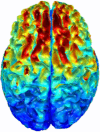The impact of a tDCS and cognitive training intervention on task-based functional connectivity
- PMID: 38265579
- PMCID: PMC11009202
- DOI: 10.1007/s11357-024-01077-4
The impact of a tDCS and cognitive training intervention on task-based functional connectivity
Abstract
Declines in several cognitive domains, most notably processing speed, occur in non-pathological aging. Given the exponential growth of the older adult population, declines in cognition serve as a significant public health issue that must be addressed. Promising studies have shown that cognitive training in older adults, particularly using the useful field of view (UFOV) paradigm, can improve cognition with moderate to large effect sizes. Additionally, meta-analyses have found that transcranial direct current stimulation (tDCS), a non-invasive form of brain stimulation, can improve cognition in attention/processing speed and working memory. However, only a handful of studies have looked at concomitant tDCS and cognitive training, usually with short interventions and small sample sizes. The current study assessed the effect of a tDCS (active versus sham) and a 3-month cognitive training intervention on task-based functional connectivity during completion of the UFOV task in a large older adult sample (N = 153). We found significant increased functional connectivity between the left and right pars triangularis (the ROIs closest to the electrodes) following active, but not sham tDCS. Additionally, we see trending behavioral improvements associated with these functional connectivity changes in the active tDCS group, but not sham. Collectively, these findings suggest that tDCS and cognitive training can be an effective modulator of task-based functional connectivity above and beyond a cognitive training intervention alone.
Keywords: Cognitive training; Functional connectivity; Transcranial direct current stimulation; UFOV; tDCS.
© 2024. The Author(s), under exclusive licence to American Aging Association.
Conflict of interest statement
The authors declare no competing interests.
Figures






Similar articles
-
Non-pharmacological interventions for improving language and communication in people with primary progressive aphasia.Cochrane Database Syst Rev. 2024 May 29;5(5):CD015067. doi: 10.1002/14651858.CD015067.pub2. Cochrane Database Syst Rev. 2024. PMID: 38808659 Free PMC article.
-
Non-invasive brain stimulation techniques for chronic pain.Cochrane Database Syst Rev. 2018 Mar 16;3(3):CD008208. doi: 10.1002/14651858.CD008208.pub4. Cochrane Database Syst Rev. 2018. Update in: Cochrane Database Syst Rev. 2018 Apr 13;4:CD008208. doi: 10.1002/14651858.CD008208.pub5. PMID: 29547226 Free PMC article. Updated.
-
Non-invasive brain stimulation techniques for chronic pain.Cochrane Database Syst Rev. 2018 Apr 13;4(4):CD008208. doi: 10.1002/14651858.CD008208.pub5. Cochrane Database Syst Rev. 2018. PMID: 29652088 Free PMC article.
-
Transcranial direct current stimulation (tDCS) for improving activities of daily living, and physical and cognitive functioning, in people after stroke.Cochrane Database Syst Rev. 2016 Mar 21;3(3):CD009645. doi: 10.1002/14651858.CD009645.pub3. Cochrane Database Syst Rev. 2016. Update in: Cochrane Database Syst Rev. 2020 Nov 11;11:CD009645. doi: 10.1002/14651858.CD009645.pub4. PMID: 26996760 Free PMC article. Updated.
-
The effects of aerobic exercise and transcranial direct current stimulation on cognitive function in older adults with and without cognitive impairment: A systematic review and meta-analysis.Ageing Res Rev. 2022 Nov;81:101738. doi: 10.1016/j.arr.2022.101738. Epub 2022 Sep 23. Ageing Res Rev. 2022. PMID: 36162707
Cited by
-
Enhanced cognitive outcomes with telehealth-based tDCS in multiple sclerosis: Results from a sham-controlled RCT.Mult Scler J Exp Transl Clin. 2025 Jul 28;11(3):20552173251356704. doi: 10.1177/20552173251356704. eCollection 2025 Jul-Sep. Mult Scler J Exp Transl Clin. 2025. PMID: 40735472 Free PMC article.
-
Electrical brain networks before and after transcranial pulsed shockwave stimulation in Alzheimer's patients.Geroscience. 2025 Feb;47(1):953-964. doi: 10.1007/s11357-024-01305-x. Epub 2024 Aug 27. Geroscience. 2025. PMID: 39192004 Free PMC article.
-
Boosting working memory in the elderly: driving prefrontal theta-gamma coupling via repeated neuromodulation.Geroscience. 2025 Apr;47(2):1425-1440. doi: 10.1007/s11357-024-01272-3. Epub 2024 Jul 12. Geroscience. 2025. PMID: 38992335 Free PMC article. Clinical Trial.
-
Transcranial direct current stimulation and neuronal functional connectivity in MCI: role of individual factors associated to AD.Front Psychiatry. 2024 Aug 19;15:1428535. doi: 10.3389/fpsyt.2024.1428535. eCollection 2024. Front Psychiatry. 2024. PMID: 39224475 Free PMC article.
References
Publication types
MeSH terms
Grants and funding
LinkOut - more resources
Full Text Sources
Miscellaneous

